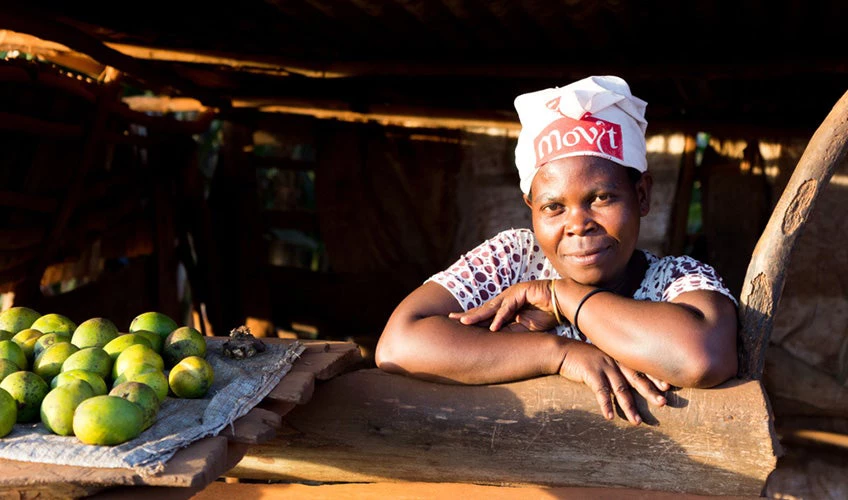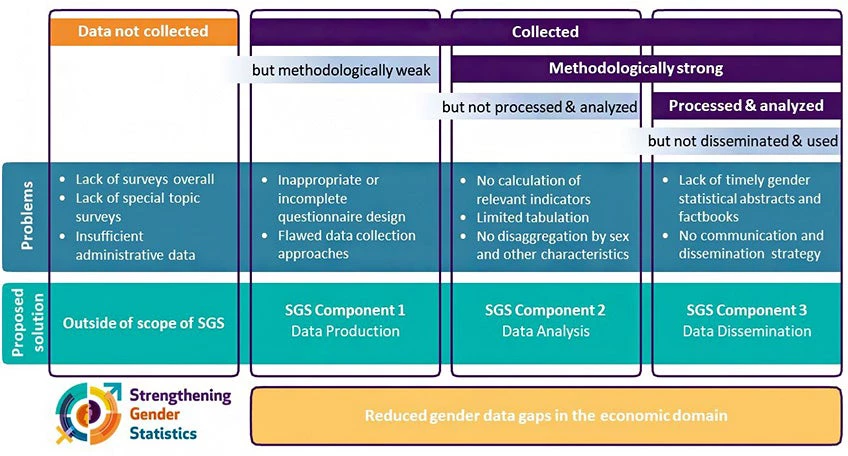
World Bank Strengthening Gender Statistics project is partnering with National Statistical Offices in twelve IDA-19 countries to support the production of gender data in the economic domain.
Why gender data?
Next year marks the 10-year anniversary of the World Development Report 2012 on gender and development. Gender data is essential as we revisit remaining obstacles to the promise of productive and self-determined lives for women and girls globally: to measure and report on progress achieved and to design meaningful policies moving forward.
Gender data go well beyond sex-disaggregation. Contrary to popular belief, gender data is not only on women or women’s issues but encompass the full range of the life cycle intersecting with all sectors from getting a proper ID at birth to accessing quality education to getting a decent job to using public transport and feeling safe at home and in public spaces. Gender data also pays specific attention to women and men’s different realities and how those interact with other forms of individual characteristics.
The foundation for designing effective policies that benefit women and men, girls and boys, gender data is often incomplete, methodologically flawed, or completely lacking. Consequences of inadequate gender data are dire: social and economic policies are less impactful, opportunities to improve project design are missed, and a blind eye is turned to stubborn inequalities in gendered social and economic realities.
How to tackle gender data gaps?
To address this issue in our partner countries and generate lessons for a global engagement on gender statistics, the World Bank, with support from the Bill and Melinda Gates Foundation, is implementing the Strengthening Gender Statistics (SGS) project.
SGS draws on expertise from the Gender Group, the Poverty and Equity Global Practice, and the Development Data Group’s Living Standards Measurement Study (LSMS) program, to provide technical assistance to select IDA countries on improving gender data production and dissemination of gender statistics, with a focus on the economic domain.
In doing so, the project is leveraging our long-standing engagements with national statistical offices, and our concerted efforts in the recent past, through the LSMS+ Initiative and the Women’s Work and Employment Partnership, to improve the availability and quality of individual-disaggregated survey data on economic outcomes.
Through a demand-driven process, SGS is currently supporting twelve IDA countries with ongoing or planned statistical operations to improve the scope and quality of their gender data and statistics.
Homing in on women and girls’ economic opportunities and outcomes
To make the most of available resources the SGS project targets gender data gaps specifically in the areas of employment, entrepreneurship, and asset ownership and control. Women’s economic empowerment is instrumental to ending extreme poverty and promoting shared prosperity and expanding survey data collection on these topics is a priority for the World Bank. Additionally, this focus is complementary to other partners' efforts in improving gender data such as the UN Women Count project and the multi-donor 50x2030 initiative. Narrowing existing gaps within economic statistics has also been identified as a policy priority among many partner countries.
Leveraging existing engagements with National Statistical Offices globally
The SGS project is collaborating with National Statistical Offices from a diverse set of countries and regions ranging from Bangladesh and Lao PDR in Asia to several Western African countries including Benin, Burkina Faso, Cameroon, Ghana, Mali, and the Republic of Congo as well as Tanzania, Somalia and Madagascar in Eastern Africa, and Djibouti representing the MENA region. While each country is facing unique data challenges, they are united in their desire to improve the availability and quality of their gender data.
Tackling the various sources of gender data gaps – one at a time
The SGS project is designed to mainstream the adoption of international best practices in the production of economic gender data. There are several entry points to effectively address these gaps. Our approach recognizes that data impediments can emerge at different stages of the data life cycle.
Data gaps arise due to various reasons…
… and require a holistic approach to be narrowed and closed
Broadly, problems can be grouped into three categories:
- Data production: Significant investments have been made to address methodological concerns and practical challenges related to economic gender data. New evidence has emerged from projects such as LSMS+ and the Women’s Work and Employment Partnership on the implications of respondent selection, updated guidance on employment indicators, and the urgency of sex-disaggregation. These findings demonstrate the need and value of adopting a gender lens in the survey design process. However, advances in measuring women’s economic status are often not translated into survey operations. The SGS project provides targeted fixes to survey design and implementation protocols within each country’s specific survey context.
- Data analysis: Even where data are being disaggregated by sex, in-depth analysis of that data is not always undertaken. Too often, gender data use is hindered by limited tabulation and dissemination of existing data. As a result, the uptake and use of gender data are challenged in the translation and communication of statistics to less technical audiences and leveraged in policy dialogue. The SGS project offers country-tailored data analysis training on generating basic gender statistics calculated using internationally recognized methodology.
- Data Dissemination: Efforts to collect high-quality gender data are only helpful if the data is used. Disseminating collected data is not going the extra mile, but a fundamental step in the data production cycle to ensure uptake and use of data for policymaking. The SGS project supports the production of gender abstracts and factbooks and works with partner countries to promote the dissemination of data sets and associated reports.
Our vision: Starting a new chapter for economic gender data
Specific activities within these three categories are defined based on the needs of the partner country and depending on the country context. Results are expected by the end of 2023 and implementation will be shared throughout the duration of the SGS project. Equipped with new and better gender data, partner countries will be in a better position to shape the economic lives and livelihoods of a new generation. Producing, leveraging, and sharing gender data is critical to AccelerateEquality in the next decade. For access to more than 900 gender-related indicators, please visit the World Bank Gender Data Portal, the World Bank Group’s comprehensive source for the latest sex-disaggregated data and gender statistics.






Join the Conversation